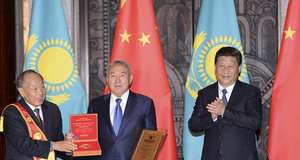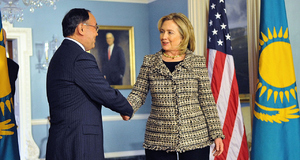The Effect of CEDAW Ratification in Central Asia
By
2011, Vol. 3 No. 05 | pg. 1/1
KEYWORDS:
Despite the increasing number of states that have ratified binding international human rights treaties, human rights abuses continue unabated. The persistence of rights abuses cast doubt on the efficacy of human rights treaties. This paper empirically examines whether ratification of international human rights treaties affects state human rights practices. Specifically, it examines whether ratification of the Committee on the Elimination of Discrimination against Women (CEDAW) decreases the likelihood that states will abuse women’s rights or allow such rights to be abused. From 1981-2009, there has been a similarity regarding women’s rights between most states in the Central Asian region. In the early years of this data collection, the states generally had a very small amount of focus or complete disregard towards the equality of women. The CIRI Human Rights Data Project indicates that there was little equality as far as economic, political, or social variables when it came to women in the beginning years of the data analysis, but as time progressed closer to present day, movement towards equality in every category for most states began to be more visible. If ratification of CEDAW is related to women’s economic, political, and social rights, one would expect states that have ratified CEDAW to respect the rights of women more than states that have not ratified. I use the CIRI Human Rights Data Project measure of women’s economic, political, and social rights to analyze this hypothesis. The CIRI human rights data project’s measure of women’s economic, political, and social rights consists of a scale of 0 (no rights) to 3 (equal rights). The following is analysis of the data itself and the average scores given to the region from 1981-2009.The criteria that the CIRI Human Rights Data Project uses in determining economic rights data involves equal work for equal pay, no discrimination when it comes to hiring, free choice of what job to pursue, no sexual harassment, job security, etc. According to the CIRI Human Rights Data Project, “A score of 0 indicates that there were no economic rights for women in law and that systematic discrimination based on sex may have been built into law. A score of 1 indicates that women had some economic rights under law, but these rights were not effectively enforced. A score of 2 indicates that women had some economic rights under law, and the government effectively enforced these rights in practice while still allowing a low level of discrimination against women in economic matters. Finally, a score of 3 indicates that all or nearly all of women’s economic rights were guaranteed by law and the government fully and vigorously enforces these laws in practice.” (Cingranelli and Richards, CIRI). The average score in Central Asia pertaining to the economic equality of women is 0.9, which indicates that there is major work to be done. This suggests that the average woman in Central Asia is subject to some economic rights, but the government does not enforce these rights effectively. If the government is unable to enforce these rights, then there is no point in having the rights in the first place. The state with the highest present day economic score is Bhutan with a score of 3. According to the dataset, women in Bhutan are living an economic life relatively equal to that of men. The state receiving the lowest score is Iran with a score of 0. This means that Iran has no laws built into place that concern the equality of women. Iran has yet to ratify the CEDAW treaty, so this could be a correlation that shows that states that have ratified the treaty do have a better score pertaining to women’s economic rights. On the contrary, Afghanistan also received a 0 in women’s economic rights even after they ratified CEDAW in 2003. The next category of research, women’s political rights, consists of the right to vote, run for office, join political parties, hold government positions, and petition government officials. The scoring scheme in this category, according to the CIRI Human Rights Data Project, goes like so: “A score of 0 indicates that women’s political rights were not guaranteed by law during a given year. A score of 1 indicates that women’s political rights were guaranteed in law, but severely prohibited in practice. A score of 2 indicates that women’s political rights were guaranteed in law, but were still moderately prohibited in practice. Finally, a score of 3 indicates that women’s political rights were guaranteed in both law and practice.” (Cingranelli and Richards, CIRI). The average score in Central Asia in regards to political equality is 1.55; compared to economic equality, this can be considered progress. This data suggests that the average woman in Central Asia is to expect to have political rights promised by law, but be severely to moderately prohibited in practice. Does this really mean that women have political rights? In the majority of the states in Central Asia, there are no women in office or holding important roles in politics. Women may be able to vote, but I see no equality when it come political rights and women. The highest score for political rights is shared by India, Kazakhstan, and Uzbekistan at 2. These states seem to be making progress compared to the other states of the region. The lowest score belongs to Iran with an average of .59, which indicates that women have pretty much no political rights. The last category being examined, social rights, is expressed by the right to participate in social activities, be exempt from genital mutilation, travel abroad, get a divorce, inheritance, own property, etc. The CIRI Human Rights Data Project defines the scores as “A score of 0 indicates that there were no social rights for women in law and that systematic discrimination based on sex may have been built into law. A score of 1 indicates that women had some social rights under law, but these rights were not effectively enforced. A score of 2 indicates that women had some social rights under law, and the government effectively enforced these rights in practice while still allowing a low level of discrimination against women in social matters. Finally, a score of 3 indicates that all or nearly all of women’s social rights were guaranteed by law and the government fully and vigorously enforced these laws in practice.” (Cingranelli and Richards, CIRI). The average score given to the region of Central Asia was a .77; this is by far the lowest average score of the three categories being examined. The average woman in Central Asia can expect to have little to no social rights under law and can certainly expect the government not to enforce these laws at all if there are any in the first place. The highest average score belongs to the state of Kyrgyz Republic with a 1.64. This is peculiar because the Kyrgyz Republic actually has a woman interim president named Rosa Otumbaeva, who is the first woman to hold this status in office within any state in the whole region. The lowest score, again, belongs to Iran with a score of 0. The situation in Iran concerning women’s rights in each category is dire; the state has received abysmal scores in each category being examined and may be at a point where foreign powers should interfere and help out enforcing human rights practices as a whole. After examining the data so far, it looks like it is agreeing with my hypothesis in that ratification of the CEDAW treaty does not make a state more likely to enforce women’s rights laws. There are some aspects of the data that suggest otherwise though, for example, Iran is the only state in Central Asia that has not ratified CEDAW and they have the lowest score in each category of women’s rights being examined. This doesn’t seem to be a coincidence either since all the other states that have ratified have received higher scores in average from 1981-2009. The present day outlook of states regarding human rights seems to be universal with the mindset that there should to be a need for fulfillment in the world to practice human rights movements;“This is a global trend, as states everywhere move to place human rights education on their national agendas” (Cardenas, 363). This may be the new trend of states to strive for human rights treaties such as CEDAW to take place, but for this movement to actually leave a lasting effect on the world, states need to actually commit to putting these agendas in operation. The data seems to signify a correlation between states that have been war stricken or Islamic following states. In Central Asia, there are serious political problems that are still lingering from most of the region’s sudden independence from the Soviet Union in the early 1990’s. These problems, along with some of the basic viewpoints of the Islamic religion that is practiced throughout the land contribute to the current distribution of human rights protection. Branching off from the incorporation of human rights, women’s rights in Central Asia had not been much of a factor, “in recent years, there have been frequent and ongoing efforts, to encourage a wide variety of international human rights implementation mechanisms to mainstream, or integrate, a gender analysis into their operations. The CEDAW Convention, through its terms and its advocates, has been an integral part of this approach” (Bayefsky, 198). This implementation of the CEDAW human rights treaty has been ratified by every state in Central Asia except Iran. The only states to have ratified the treaty within 5 years of proposal were Bhutan, Bangladesh, and Sri Lanka. Out of these 3 states that ratified the CEDAW treaty relatively quickly compared to the other states of Central Asia, only Sri Lanka and Bangladesh seem to be having success with implementing women’s equality while Bhutan is struggling. This kind of data is suggesting that there has been general progress in the economic, political, and social equality of women in these states. Still, there is plenty room for more progress in these states. Many of the states of Central Asia follow Islam: “women's experience within Islam, as well as their response to it, differs from state to state. Islamic feminists have long maintained that Islam itself is not oppressive toward women, but that it has become so in many places as a result of incorrect interpretations of the Koran by men, as well as through the assimilation of non-Islamic cultural traditions” (Cooper and Traugott, 61). The only non-Muslim states in Central Asia are Bhutan, India, Nepal, and Sri Lanka. Surprisingly, there is not much of a difference in the 2009 data regarding women’s rights in economics, politics, or social categories whether the state follows Islamic practices or not. Women’s political rights are the highest out of the 3 categories. Though the women’s rights in the other two categories are not considered to be having much progress, the stereotype that Islamic states are more suppressive towards women does not seem to cause much of a difference when compared to the 4 states of Central Asia that do not have a majority population of Islamic followers. This doesn’t mean that women’s equality is on the rise in Islamic populations, but there is some signs of progress shown from when the CEDAW convention was first introduced. In the states of Central Asia where woman’s rights seemed to be next to invisible after World War II, CEDAW made an immediate impact. For example, “in Pakistan, the adoption of CEDAW has sparked new debate over women's roles, invigorated the women's movement, and pushed the government to establish an autonomous National Commission for women…” (Gray, Kittilson, and Sandholtz, 301). This debate that has been sparked is not only apparent in Pakistan, but in all the states in Central Asia whether subject to an Islamic following population or not. CEDAW seems to have caused these states to notice how important the advancement of women in all aspect of society is becoming to the rest of the world. The problem with these states that have ratified CEDAW is that they don’t really enforce the advancement of woman’s rights. The actual treaty in itself is not very strong, “the CEDAW does not provide for enforcement of its terms, but it does require state parties to submit reports to a designated UN committee” (Hathaway, 592). This is clearly visible by looking at the CIRI Human Rights Data Project; the majority of states of Central Asia have agreed to ratify the CEDAW treaty, but where is the enforcement? There are no officials checking on each state to make sure they are fulfilling the treaty to improve the rights of women. All the CEDAW treaty is requiring is that each state submits a report on how the progress of the treaty is coming along; “Since the reports depend primarily on information submitted by governments, the obvious danger is that the governments may attempt to present information in the best light possible and to suppress any information which shows that they have not complied with the obligations.” (Ngaba, 86). This is most definitely not an ideal way to enforce the CEDAW and leaves the government open to commit corruption by giving false reports about their enforcement. I would like to be able to say that there is progress being made by these Central Asian countries in respect to women’s rights, but as we examine the CIRI Human Rights Datasets, there is not much to be excited about. I thought it would be interesting to compare both the CEDAW ratification data and the CIRI Human Rights Data Project’s findings on women’s rights between the regions of Central Asia and Northern Europe. These regions are very different in that Central Asia consists mainly of developing states while Northern Europe consists of mainly developed states. This proposes an even deeper level of analysis and should demonstrate a relationship between women’s rights and whether the state is developed or developing. All 10 of the states in Northern Europe have ratified the CEDAW treaty and the analysis shows that the average scores in Northern Europe far surpass the scores in Central Asia. The average score in Northern Europe relating to economic rights is 2.08 compared to .91 in Central Asia. The average score in Northern Europe relating to political rights is 2.37 compared to 1.55 in Central Asia. Lastly, the average score in Northern Europe relating to social rights is 2.40 compared to .77 in Central Asia. Northern Europe out performs Central Asia in enforcing every category of women’s rights and in 2009 Denmark, Finland, Norway, and Sweden all boasted a perfect score of 3 in every category. In the case of Europe, it seems like my hypothesis is proven wrong and that ratification of CEDAW does improve the economic, political, and social rights for women; yet in Central Asia, the data shows that my hypothesis is accurate. These contradicting outcomes of data analysis lead me to a totally different conclusion that throws my original hypothesis out the door. The ratification of CEDAW is irrelevant when thinking of the advancement of women’s rights. It may have good intentions, but the treaty is very flawed in that there is no enforcement mechanism to secure the fulfillment of states to carry out the implications of the treaty. After comparing the CEDAW ratification data and CIRI Human Rights Data of women’s rights with Central Asia and Northern Europe, It is clear that CEDAW ratification does not reflect directly with how women’s rights are implemented in each region. For example, every state in the region of Central Asia has ratified CEDAW, except for Iran, and yet they have achieved very poor scores in the area of economic, political, and social rights. Does the ratification of CEDAW decrease the likelihood that states will abuse the women’s rights of their citizens? The data analysis suggests that there is a more complex answer than a simple yes or no. In some states CEDAW contributes to helping women’s rights, but in others, the ratification of the CEDAW treaty is not a huge factor in whether or not states will abuse the women’s rights of their citizens. What really seems to matter is the whether the state is developed or developing, what types of resources are available, what religion is followed by the population, and how well a country is doing economically. Women may be getting the opportunity to finally be held equal to men in different aspects of life in developed countries, but “especially in the underdeveloped and developing countries of the world, women suffer disproportionately from hunger, malnutrition, and lack of access to health care; they are subjected to domestic violence, rape during peacetime and war, and sexual abuse and harassment; they are denied opportunities to work outside the home and, when not, suffer from unequal pay and other discriminatory treatment; in many cases there are substantial barriers to political participation in their societies, including home confinement, illiteracy, curtailed educational opportunities, bans on public protest; and they often suffer from unequal treatment before the law, including inequality in power to make contracts, unequal treatment in courts, unequal power to hold and administer property, and unequal treatment in matters of divorce and inheritance” (Twiss, 47). Due to the unenforceability of the CEDAW treaty, it is more logical to understand that the enhancement of women’s rights depends on whether a state has the resources and will to do so. Northern Europe consists mainly of developed countries that are prosperous so it is easier to implement women’s rights practices into society. Central Asia consists of states that are struggling economically and politically. Some of the countries have the distraction of war to place the blame for the lack of women’s rights, but there also seems to be a relationship between Islamic states and lack of women’s rights. Regions that have women’s rights figured out need to show some support to getting regions like Central Asia on the right track. For the CEDAW treaty to truly have a lasting effect on societies throughout the world, there needs to be strict enforcement available. Until this time, governments of developing countries are not going to start viewing ratification of human rights treaties such as CEDAW as a serious reason for change, “in most cases, for treaty ratification to work, there must be conditions for domestic groups, parties, and individuals and for civil society to persuade, convince, and perhaps pressure governments into translating the formal promise of better human rights protection into actual reality” (Neumayer, 950). Equal rights for women are a legitimate reason for protest as all people should have the same opportunities regardless of gender. This analysis should open people’s eyes to how CEDAW ratification really affects women’s rights in Central Asia, change needs to take place in this region soon, or else women in the region will continue to be subject to inequality.
References Bayefsky, Anne F. , Denesha Reid, and Kathryn Balmforth. "The CEDAW Convention: Its Contribution Today." Proceedings of the Annual Meeting (American Society of International Law) 94 (200): 197-203 . jstor. Web. 23 Feb. 2011. Cardenas, Sonia. "Constructing Rights? Human Rights Education and the State." International Political Science Review / Revue internationale de science politique 26.4 (2005): 363-379. jstor. Web. 23 Feb. 2011. Cingranelli, David L., and David L. Richards. "CIRI Human Rights Data Project." humanrightsdata.org. N.p., n.d. Web. 23 Feb. 2011. . Cohrs, Christopher J., Jürgen Maes, Barbara Moschner, and Sven Kielmann. "Determinants of Human Rights Attitudes and Behavior: A Comparison and Integration of Psychological Perspectives." Political Psychology 28.4 (2007): 441-468. jstor. Web. 23 Feb. 2011. Cooper, Belinda, and Isabel Traugott. "Women's Rights and Security in Central Asia." World Policy Journal 20.1 (2003): 59. EBSCO. Web. 23 Feb. 2011. Gray, Mark M. , Miki Caul Kittilson , and Wayne Sandholtz. "Women and Globalization: A Study of 180 Countries, 1975-2000." International Organization 60.2 (2006): 293-333. jstor. Web. 23 Feb. 2011. Hathaway, Oona A.. "Why Do Countries Commit to Human Rights Treaties?." The Journal of Conflict Resolution 51.4 (2007): 588-621 . jstor. Web. 23 Feb. 2011. Neumayer, Eric. "Do International Human Rights Treaties Improve Respect for Human Rights?." The Journal of Conflict Resolution 49.6 (2005): 925-953. Print. Ngaba, Sindiso . "CEDAW: Eliminating Discrimination against Women." Agenda 27 (1995): 81-89. jstor. Web. 23 Feb. 2011. Twiss, Sumner B. . "History, Human Rights, and Globalization." The Journal of Religious Ethics 32.1 (2004): 39-70. jstor. Web. 23 Feb. 2011. Suggested Reading from Inquiries Journal
Inquiries Journal provides undergraduate and graduate students around the world a platform for the wide dissemination of academic work over a range of core disciplines. Representing the work of students from hundreds of institutions around the globe, Inquiries Journal's large database of academic articles is completely free. Learn more | Blog | Submit Latest in Political Science |


















